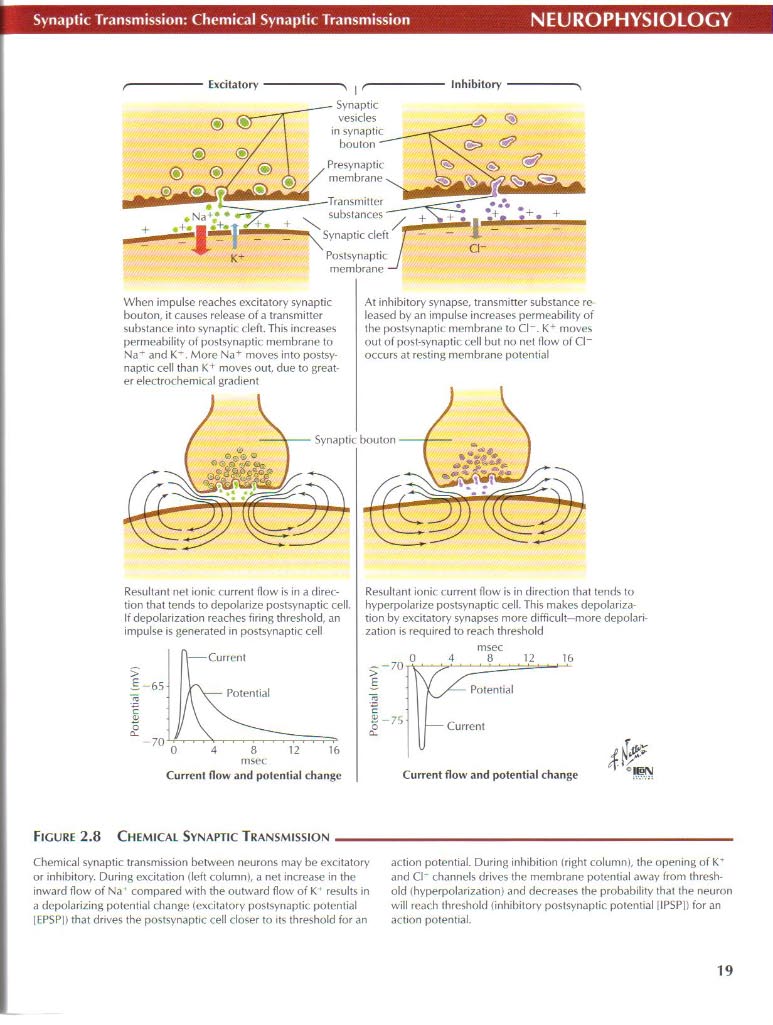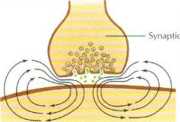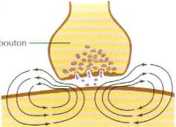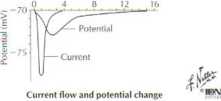17540 netter9

NEUROPHYSIOLOGY
Synaptic Transmission: Chemical Synaptic Transmission
s Excitatorv-\ , /- Inhibitory
in synaptic
Presynaptic
Synaptic delt
Postsynaptic
Whon impulse roaches oxcitatory synaptic bouton. it causes release of a transmitter substance into synaptic cleft. This increases permeability ul postsynaptic membranę to Na* and K* Morę Na* moves into postsy-naptic celi than K1 moves out. due to great-er electrochemical gradient

At inhibitory synapsę, transmitter substance re leased by an impulse increases permeability of the postsynaptic membranę to Cl-. K* moves out of post-synaptic celi but no net (Iow of Cl* occurs at resting membranę potential

Resultant net ionic rurrent flow is in a direc-tion that tends to depolarize postsynaptic celi If depolarization reaches finng threshold, an impulse is generated in postsynaptic celi

Currenl flow and potential change
Resultant ionic cunrent flow is in rłirection that tends to hyperpolarize postsynaptic celi. This makes depolariza tion by excitatory synapses morę ditficult—morę depolarization is required to reach threshold
msec

Figurę 2.8 Chemical Synaptic Transmission _
Chemical synaptic transmission between neurons may be excitatory or inhibitory. During excitation (left column), a net inerease in the inward flow of Na1 compared with the outward flow of K' results in a dcpolarizing potential change (cxcilatory postsynaptic potential |EP$P|> that dnves the postsynaptic celi doser to its threshold for an action potential. During inhibition iright column i, the opening of K' and Cl* channels drives the membranę potential away from thresh-old (hyperpolarizationj and decreases the probability that the neuron will reach threshold (inhibitory postsynaptic. potential llPSPlł for an action potential.
19
Wyszukiwarka
Podobne podstrony:
47720 netter8 NEUROPHYSIOLOGYSynaptic Transmission: Inhibitory Mechanisms Figurę 2.7 Synaptic Inhibi
netter5 NEUROPHYSIOLOCYSynaptic Transmission: Morphology of Synapses Numęrous boutons (synaptic knob
netter7 NEUROPHYSIOLOGYSynaptic Transmission: Yisceral Efferenł Endings ■ A. Smooth musclc B. Gland
netter6 NEUROPHYSIOLOGYSynaptic Transmission: Neuromuscular Junction r Acetylcholine
netter10 NEUROPHYSIOLOGYSynaptic Tr.insmission: Temporal and Spatial Summation C. Icmporal exritator
netter11 NEUROPHYSIOLOGYCerebrospinal Fluid (CSF): Brain Ventricles and CSF Composition Frontal (ant
netter2 NEUROPHYSIOLOGY Central sulcus (Rotando)Organizalion of Ihe Brain: Cerebrum Postcentral gyru
netter20 NEUROPHYSIOLOGYThe Cerebral Cortex Sm!,} Spn4,,,v Sensory Promotor; orientation, eye and
netter24 NEUROPHYSIOLOGYCutaneous Sensory Receplors Melanoryte Arrectot muscle ofliair, Sebaceous gl
netter30 NEUROPHYSIOLOGY Sensory Pathways: I Spinothałamic iract lower part of medulla
netter36 NEUROPHYSIOLOGY Audilory System: Pathways temporal lobe cortex Medial geniculate body High
netter40 NEUROPHYSIOLOGYGustatory (Taste) System: Pathways Sensory cortex łjust below face area) Lat
więcej podobnych podstron